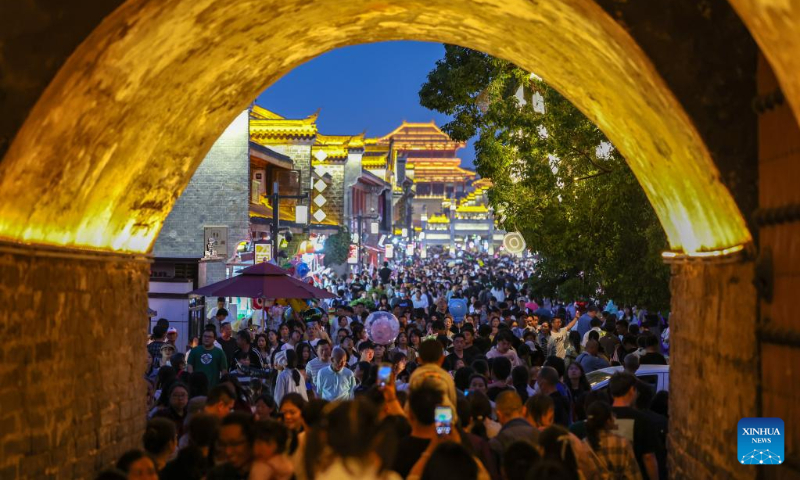May Day holidays set to be 'most prosperous'
Consumption firing on all cylinders, mirroring the strength, sustainability of economy recovery: industry insiders

Tourists enjoy night time at the ancient town of Xiangyang City, central China's Hubei Province, April 30, 2023. (Photo by Yang Dong/Xinhua)
China's consumption has been firing on all cylinders during the just-ended May Day holidays, ranging from tourism, box office, transportation, entertainment to catering sectors. This year's five-day holidays are believed to have beaten the 2019 pre-epidemic level in terms of both trips made and revenue generated to become what industry insiders celebratedas the "most prosperous," giving a huge boost to GDP.
From the barbecue craze in Zibo, an industrial city in East China's Shandong Province, the camel-riding "traffic jam" in a desert spot in Dunhuang, Northwest China's Gansu Province to the lengthy queues at the doorstep of naughty, fluffy giant panda Meng Lan at Beijing Zoo, tourist destinations across the country were flooded with millions of Chinese visitors, who set their sights on the May Day holidays - the first long break after the seven-day Spring Festival holidays - to release pent-up travel desire.
The tourist boom offers an unmistakably sign that the world's second-largest economy has been steadily moving out of the epidemic haze after three tedious years, analysts said. More importantly, it shed light on the strength and sustainability of China's consumption rebounding momentum, which analysts predict could wow global investors with double-digit growth in the second quarter of the year and serve as a major pillar underpinning a whole-year economic recovery of above 5 percent.
A total of 274 million trips were made during the May Day holidays this year, up 70.83 percent year-on-year, equivalent to 119.09 percent of 2019's on a like-for-like basis, according to data released by the Ministry of Culture and Tourism late on Wednesday. Domestic tourism income soared 128.9 percent year-on-year to 148.1 billion yuan ($21.43 billion), slightly higher than in 2019 on a comparable basis at 100.66% of 2019.
The national railway network is set to transport 19.35 million passengers on Wednesday, the last day of the five-day holidays that started on April 29, according to China Railway. It represents roughly a 400 percent increase from that of 2022 based on the Global Times' calculations.
According to a report that online travel agency Qunar sent to the Global Times on Wednesday, the number of people who simultaneously purchased online rail ticket set a record high, and tickets for popular rail routes during the holidays sold out within minutes, "at a speed even faster than during the Spring Festival travel rush."
Data from industry information provider VariFlight showed that the number of domestic passenger flights reached 13,926 on Wednesday, about 4.4 times that of last year.
Unprecedented traffic flow
The May Day holidays this year have been marked by unprecedented crowds and frenzy shopping spree, with multiple tourist venues reporting tickets selling out.
Quiet a many hotspot tourist sites have been operating at maximum capacity, such as the Great Wall in Beijing, the Xi'an City Wall in Xi'an of Northwest China's Shaanxi Province, and the West Lake in Hangzhou, East China's Zhejiang Province, according to travel platform data.
Accommodation bookings in popular tourist cities surpassed the pre-virus level by 1.9 times, Qunar data showed. Even previously less popular tourist cities, such as Dehong in Southwest China's Yunnan Province, Gannan in Gansu, and Ili Kazakh Autonomous Prefecture in Northwest China's Xinjiang Uygur Autonomous Region, witnessed big spikes in traffic flow, driving up an over tenfold surge in local hotel bookings from 2019.
Zibo, one of the hottest travel destinations that gained prominence on China's social media platforms for its affordable barbecue food, saw hotel reservations jump by 20 times from 2019, according to data from Qunar. The sudden influx of visitors, which exceeded the city's capacity, prompted local authorities to advise people to avoid traveling to the city at peak time.
"Although not yet dinner time, barbecue stalls in Zibo are full. A shopkeeper told me that the store prepares more than 20,000 skewers of meat every day to meet huge demand," a white-collar worker surnamed Zhang told the Global Times on Wednesday.
In addition to delicious food and good services provided by the local government, Zhang attributed the major reason behind the popularity to an explosion in consumer demand, which has been suppressed in the past three years.
Throughout the May Day holidays, Chinese social media sites were abuzz with pictures and posts featuring Chinese tourist attractionsoverwhelmed with swarms of people, which drew a host of humorous online discussions by netizens.
For example, memes of a "camel-riding traffic jam" at Yueyaquan scenic area, an ancient "Silk Road" in Dunhuang, went viral. According to a report by Beijing Youth Daily, the congestion was due to the drastic uptick in tourists, which reached around 20,000 to 30,000 every day during the holidays whereas there are only 2,400 camels in service. The site operators, as a result, reportedly erected traffic lights to guide the camel riding activities.
Crowds are also palpable on the waterways. A raft congestion in Wuzhishan, South China's Hainan Province, was in the limelight during the holidays. Some netizens made a humorous comparison that the hundreds of floating rubber boats stuck at the site were like "dumplings cooking in boiling water."
Despite travel jams, Chinese tourists said the roaring back of the tourism sector has brought them long-awaited excitement and joy.
"I can obviously feel the enthusiasm of people traveling after the optimization of the COVID-19 response, as I've seen large crowds in popular spots in Chongqing, such as Hongyadong, where people enjoy the wonderful night view and river view," a Beijing-based white-collar worker surnamed Xiong told the Global Times on Wednesday.
"Most tourists aren't wearing masks, which shows that the impact of the epidemic has almost dissipated," she noted.
The May Day holidays are the first long holidays after China resumed outbound group tours in February.
Data from Chinese travel agency Trip.com shows that during the long break, the number of outbound travel bookings placed by Chinese mainland tourists grew roughly 700 percent compared with last year's.
A frenzy shopping spree
While the bustling tourism sector has fueled a considerable surge in demand growth, people who chose to stay at home have opted to dine out, watch movies and enjoy entertainment activities, which all fan the flames of full-fledged consumption acceleration.
An employee at a sauced meat shop at Hangzhou railway station, East China's Zhejiang Province, told the Global Times that as there was "explosive" demand for snacks during return trips, a variety of sauced meat products, including chicken feat and duck neck, were sold out as of 11 am on Wednesday. Wednesday is the last day of the holidays when tourists head home.
According to data released by the Ministry of Commerce, sales of major retail and catering enterprises jumped 18.9 percent from a year earlier during the holiday. And key food chains saw revenues uptick by 57.9 percent year-on-year.
Data from food delivery platform Meituan showed that in the first three days of the May Day holidays, the online daily consumption volume mushroomed 133 percent compared with 2019.
Moreover, the long break also witnessed a surge in the number of moviegoers. China's holiday box-office revenue had reached 1.4 billion yuan as of 1 pm Wednesday, Chinese ticketing platform Maoyan showed, compared with 1.5 billion in 2019.
The May Day holidays serve as a yardstick for consumption. The flurry of data reflects that this year's holiday is set to be "most prosperous," ever since the data start was recorded in 2017.
"Banking on positive momentum during the holidays, retail sales growth is expected to post a double-digit rate in the second quarter, and contribute to near 80 percent of GDP [for the quarter]," Tian Yun, former vice director of the Beijing Economic Operation Association, told the Global Times on Wednesday.
He expects the positive numbers will buttress China's first-half GDP to expand at 5.5 percent. And in the second half, the revved-up economic engine would steer the Chinese economy over multiple headwinds including waning external demand and the spillover effect of a potential US finance crisis, likely propelling GDP growth to land at over 5 percent for the whole year, Tian noted.


